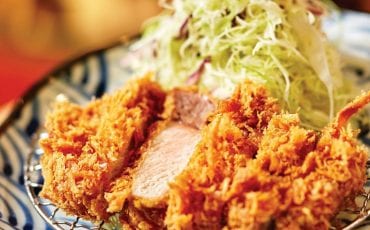Articles
Recipes
Jan 23, 2018
A Date with Datemaki
The different specialties that are served in osechi, or New Year set of food, signify the change in season. This issue, Sheila Chan tells us more about the datemaki, one of a traditional New Year dishes.
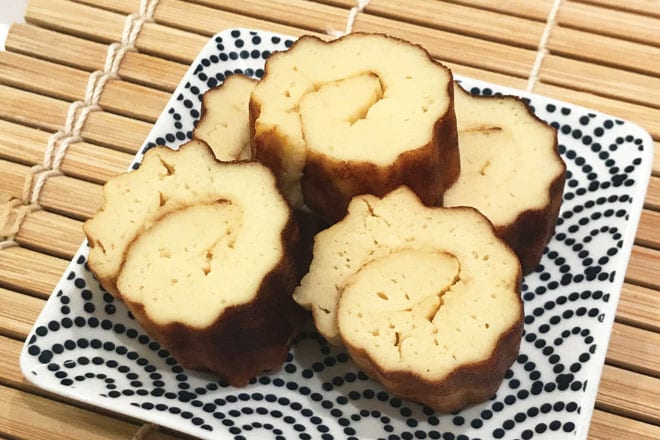
“Datemaki is a form of tamagoyaki that is usually only eaten during the Japanese New Year. For the first three days, Japanese households observe the tradition of not turning on the stove at home. According to custom, this is to allow women in the household to sit with guests and take part in the festivities, rather than be stationed in the kitchen, cooking.
Hence, most osechi consists of cooked food to be eaten at room temperature. Osechi contains a variety of food that’s stewed, grilled, or marinated with sugar and vinegar – there are usually no items that cannot be kept for three days.
Datemaki, for instance, is sweeter than the usual tamagoyaki that is eaten all year round. It is usually served together with items such as kuromame, or stewed black soybeans; cooked prawns; kazunoko, a fish roe; and ozoni, a soup with mochi and other ingredients. When guests arrive in the house, everyone gathers around and stacked boxes of osechi are served together with hot tea and otoso (flavoured saké).
The key ingredient in datemaki is hanpen, a Japanese fish cake. Unlike other fishcakes which are used in Japanese or Chinese cooking, hanpen is made with yam and egg white. This gives it a stronger fish flavour and also a lighter, fluffier texture. Hanpen can also be cut into bite-sized pieces and used in shabu-shabu and soups.
When cooking the datemaki omelette, there are three indications that it is cooked – one, its surface should look matte, not shiny; two, the bottom is nicely browned; and three, the aroma of fish cakes will emerge. Finally, a datemaki mat, made of triangular strips of bamboo, is used to give a ribbed edge to the datemaki so that when it’s cut, it resembles a scroll – an auspicious symbol of wisdom for the New Year.”
(Text Jane Ngiam / Recipes ABC Cooking Studio)
Datemaki
Ingredients (Makes 6 pieces)
2 Eggs
100g Hanpen
4 tsp Brown sugar
1/2 tbsp Mirin
1/8 tsp Soy sauce
1/4 tsp Salad oil
Directions
1. Place all ingredients except salad oil into a blender and blitz until smooth.
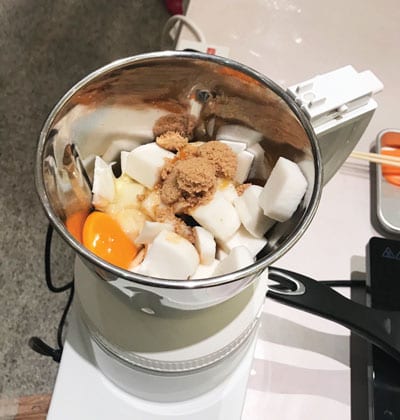
2. Heat the tamagoyaki pan over medium heat. Put salad oil in the pan. Using a pair of chopsticks, push a neatly folded piece of kitchen paper around the pan to grease it lightly and evenly.
3. Pour (1) into the pan and turn the heat to low. Using a piece of aluminium foil, cover the pan to allow the omelette to steam-cook. Set a timer for 3 minutes.
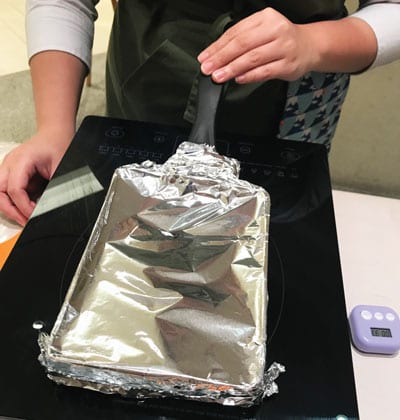
4. After 3 minutes, check the omelette. If its base is not brown yet and its surface is still shiny, cover the pan with foil again and cook for another 3 minutes.
5. When done, transfer the omelette, grilled side down, to a datemaki mat lined with plastic wrap.
6. Carefully roll the datemaki while it is hot, as this will help maintain its shape as it cools. When rolling, pull the mat towards you to get a tight grip. When rolled, wrap the datemaki in the cling wrap. Then roll it tightly again in the datemaki mat and let it cool with its seam side facing down.
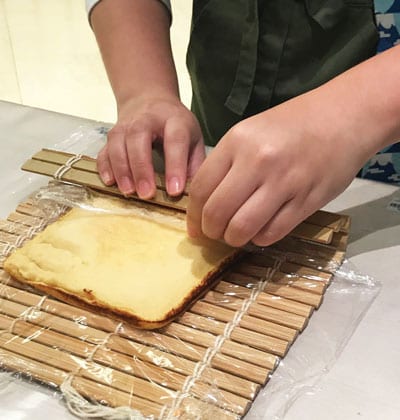
7. To serve, unwrap the datemaki and trim the sides off. Cut the datemaki into inch-wide pieces and serve.
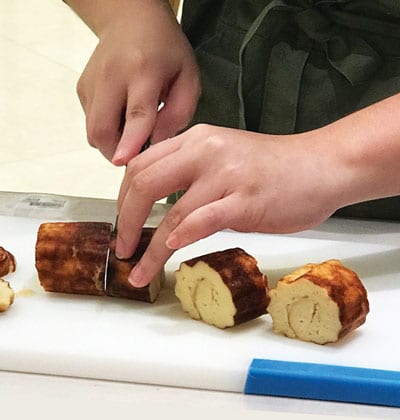
Watch how to make Datemaki at OISHII TV on YouTube
Datemaki with Cheese
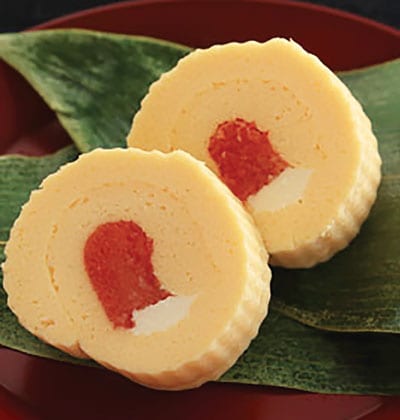 Ingredients (Makes 8 pieces)
Ingredients (Makes 8 pieces)
2 Eggs
100g Hanpen
4 tsp Brown sugar
1/2 tsp Mirin
1/8 tsp Soy sauce
1/4 tsp Salad oil
50g Mentaiko
20g Cream cheese
Directions
1. 1 portion of Datemaki recipe (see opposite page), dividing the batter to make two thinner omelettes.
2. Divide the mentaiko and cream cheese into half. Shape half the mentaiko and cream cheese into a 7cm to 8cm length and place onto the datemaki.
3. Carefully roll up the datemaki tightly. Secure the edges of the rolled mat with rubber bands.
4. When cool, unwrap the datemaki and trim off the edges.
5. Cut into 8 equal pieces to serve.
Datemaki Sushi
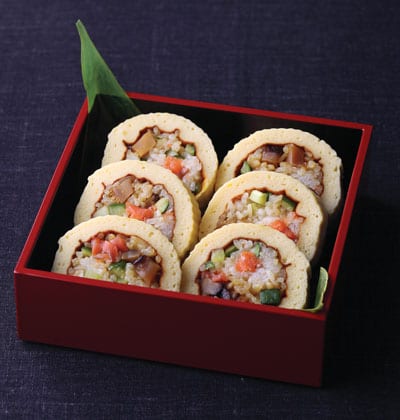 Ingredients (Makes 8 pieces)
Ingredients (Makes 8 pieces)
(A) 1 portion of Datemaki recipe (see opposite page), dividing the batter to make two thinner omelettes.
(B) Sushi Rice
100g Cooked rice
1 tbsp Vinegar
1 tsp Brown sugar
1/8tsp Salt
20g Smoked Salmon
25g Cucumber
(C) Simmered shiitake mushrooms
1pc Dried shiitake mushroom (4-5gm)
60ml Hot water
2 tsp Brown sugar
2 tsp Mirin
2 tsp Soy Sauce
Preparation for (B)
1. Combine vinegar, brown sugar and salt in a bowl. Pour over the cooked rice and mix evenly. Set aside to cool.
Preparation for (C)
1. Soak the shiitake mushroom in the hot water 10-15 minutes or until soft. Remove and lightly squeeze out excess water. Do not discard the soaking water.
2. Cut the stem and mushroom into 5mm cubes.
3. Place soaking water, brown sugar, mirin, soy sauce and the shiitake mushrooms in a small pan. Stir and simmer over a low heat until the sauce thickens. Remove from heat and set aside.
Directions
1. Cut the smoked salmon and cucumber into 5mm cubes. Put into the rice together with (C) and mix well. Divide (A) into two portions and shape each portion into a long roll about the width of the tamagoyaki pan, using cling wrap.
2. Make the datemaki, following the recipe on the opposite page. After transferring onto the mat, trim the sides to neaten the omelette. Place the rice roll onto the omelette. Roll up tightly into the datemaki mat and secure with rubber bands. Allow to cool completely.
3. Repeat step 3 with the second datemaki.
4. To serve, unwrap the datemaki and cut into 8 equal pieces to serve.








